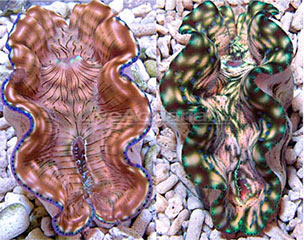- Your cart is empty
- Continue Shopping
Giant Clams for Beginners: Beautiful, Hardy & Beneficial

Giant Clams for Beginners: Beautiful, Hardy & Beneficial
If provided the proper conditions, giant clams are a great choice not only for the beginner reef aquarist, but even for the most advanced reef aquarists, offering beauty, biological benefits as well as biological diversity. Proper lighting, water movement, trace elements and placement of the giant clams will ensure the health of these fascinating invertebrates.
The clams of interest are of the genus Tridacna. These beautiful clams include: T. maxima, T. crocea, T. squamosa and T. derasa. There is amazing variation in color and pattern within these species, some resembling living pieces of art, making Tridacna clams highly desirable.
Benefits to your aquarium
Besides their beauty, clams provide another important benefit to a saltwater aquarium: natural filtration. Their superior filtering capabilities offer added stability and nutrient control in a closed aquarium system.
Excess nutrients lead to problems with low pH, algae, and cyanobacteria blooms – general poor water conditions that ultimately affect the health of all inhabitants within the aquarium.
Clams constantly filter nutrients such as ammonia and nitrate from the water thereby reducing the biological load and lowering the overall nitrate level in the aquarium, improving water conditions.
Environmental Requirements
Lighting
Proper lighting is the most critical parameter essential to the well being of giant clams. Tridacna clams not only filter nutrients from the water to satisfy their dietary needs, but also employ algae cells within their mantle called zooxanthellae. These algae cells require light as well as nutrients from both the clam and the water to properly photosynthesize. The clam then utilizes the energy the algae cells produced through photosynthesis to aid in its growth.
Clams therefore require moderate to high lighting conditions, ideally supplied by reef-compatible LED light fixtures or metal halide fixtures. If using fluorescent fixtures, simply place the clam closer to the light source.
Water Movement
Tridacna clams do not like strong, direct water currents. They prefer moderate, indirect water movement. Strong, direct water movement seems to inhibit the clam’s ability to adjust the amount of water passing through it, affecting their ability to properly filter the water.
Trace Elements
The three main trace elements giant clams require are calcium, strontium, and iodine. These elements should be present in the aquarium at or near levels found in nature. Regular water changes and routine supplementation replenish these trace elements. However, if an aquarium is heavily stocked or if aggressive chemical filtration is used, more frequent supplementation may be necessary.
Placement
Aquacultured Tridacna derasa CLOSE-UP: Aquacultured Tridacna derasa
The Derasa Clam is the most widely available and hardy of the Tridacna clams. This species is one of the largest of the “giant” clams, and grows rapidly, reaching a maximum size of approximately 20 inches. Under the proper conditions, smaller Derasa Clams can double or triple their size in less than a year. Its mantle is a mixture of orange, yellow, blue, and black and white, and usually has a wavy striped or spotted pattern, usually with vivid blues and greens. |
||||||||||||||||||||

